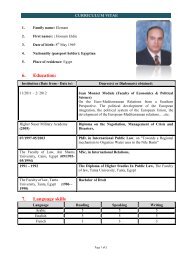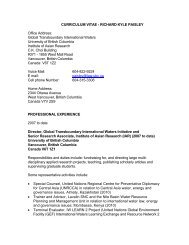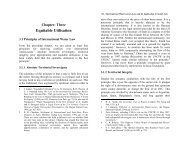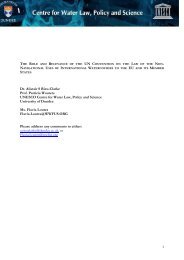Upreti, Trilochan, International Watercourses Law and Its Application ...
Upreti, Trilochan, International Watercourses Law and Its Application ...
Upreti, Trilochan, International Watercourses Law and Its Application ...
You also want an ePaper? Increase the reach of your titles
YUMPU automatically turns print PDFs into web optimized ePapers that Google loves.
PrefaceIn this book, the author has attempted to present a comprehensivereview of the evolution of water law over the centuries. While doing so, theauthor has also attempted to outline the positive <strong>and</strong> negative aspects of theinternational treaties on boundary <strong>and</strong> transboundary rivers around theworld.Like any international law in general, the one covering water sectoralso constitutes mainly the State practices, judicial pronouncements,international coventions <strong>and</strong> scholarly writings. In this book, the author hascited a profusion of examples of water disputes across the world <strong>and</strong> theways they were attempted to resolve. The author, after doing a criticalanalysis of the four doctrines of international water law, viz. territorialsovereignty, territorial integrity, prior appropriation <strong>and</strong> equitableutilization, has considered the last doctrine as the best, one, for it has wideracceptance among the international community. The author seems to be anardent supporter of the principle of equitable utilization, because he hasemphasized in a number of places in the book that the principle would helpserve the interests of the riparian States <strong>and</strong> resolve their disputes in areconciliatory manner.The book also elaborates the water availability <strong>and</strong> its potential uses inSouth Asia for the economic development <strong>and</strong> environmental sustainabilityof the region. It attempts to outline the problems <strong>and</strong> suggest the equitableutilization of rivers as solutions to them.The concept of equity <strong>and</strong> the emerging concept of equitable utilizationin shared natural resources have been dealt with at length, citing judicatureof the <strong>International</strong> Court of Justice. The readers will get an opportunity tobe acquainted with numerous international treaties on water sharing that aresaid to be based on the principle of equitable utilization.The oft-quoted Columbia River Treaty between the USA <strong>and</strong> Canadais believed to be ideally based on the principle of equitable utilization. Inthis book, this treaty is broadly suggested as an ideal point of reference fortreaty on shared watercourses based on the principle of equitable utilization.However, it is important to note that the concerned riparian States tookdecades to reach an agreement on the Columbia River water sharing. Thetreaty was not signed overnight.Helsinki Rules are believed to be the basis for principle of equitableutilization. The rules state- "each basin State in entitled within its territory toget reasonable <strong>and</strong> equitable share in the benefical uses of the water oninternational drainage basin". However, it has not been easy to determinethe reasonable <strong>and</strong> equitable share from the viewpoint of various relevantfactors <strong>and</strong> is also not possible to formulate a general rule to assign weightsto these relevant factors.Equitable utilization of resource is based on equity, i.e., fairness,faithfulness <strong>and</strong> norms of distributive justice, <strong>and</strong> the interest of everyriparian State is taken into consideration. The author has recommended theprinciple of equitable utilization to be the most ideal rule for rivers of Nepalthat flows across India <strong>and</strong> Bangladesh. Although equitable utilization isarguably the best approach to achieve justice in sharing a watercourse <strong>and</strong> ispossibly the best possible means for resolving the conflicts, the question asto "how to make the principle operational" remains unanswered, <strong>and</strong> it willbe asking too much to expect an answer from the book.Nepal, as a co-riparian State, has border rivers <strong>and</strong> also trans-boundaryrivers. A regional or sub-regional treaty on sharing water is not yet inexistence. Nonetheless, we have the experience of entering into bilateralagreements on one border river <strong>and</strong> two transboundary rivers. So far asequitable utilization is concerned, agreements on trans-boundary riversnamely Koshi <strong>and</strong> G<strong>and</strong>ak Agreements in no way illustrate the principle ofequitable utilization, whereas the agreement of border river, namelyMahakali Treaty, reflects the principle of equitable distribution to a greaterextent. However, it is important to note that the Mahakali Treaty hasascertained the equitable sharing only for the water that will be augmentedfrom the development of Pancheswore Multipurpose Project <strong>and</strong> not for thenatural flow of the river. This is owing to the integration of SardaAgreement in Mahakali Treaty. Nevertheless, Mahakali Treaty could be theframework treaty for the equitable sharing of water of border rivers, ifimplemented with good faith <strong>and</strong> sincerity.Nepal without a delay needs to develop its strategy <strong>and</strong> framework forthe equitable sharing of watercourses. In doing so, she should adoptdifferent approaches for border rivers <strong>and</strong> trans-boundary rivers. Althoughthe book is comprehensive on principle of equitable sharing, it has yet toaddress the issues adequately in the context of Nepal <strong>and</strong> her rivers.The legal aspect of India's River Linking Project has been discussed inthe book in terms of her national <strong>and</strong> international dimensions both asthreats <strong>and</strong> opportunities to the smaller neighbouring countries. The bookgives quite an insight on the project for those interested in the region's waterresources.All in all, it is a very comprehensive work dealing with water issuesfrom the naitonal, regional <strong>and</strong> global st<strong>and</strong>points. The book givessignificant information on Nepal's position on water resources. The bookseems to have a number of repetitions of some of the issues, which perhapswill be done away with in the later editions.25 December 2005-12-25 (Mahendra Nath Aryal)SecretaryXVII XVIII












